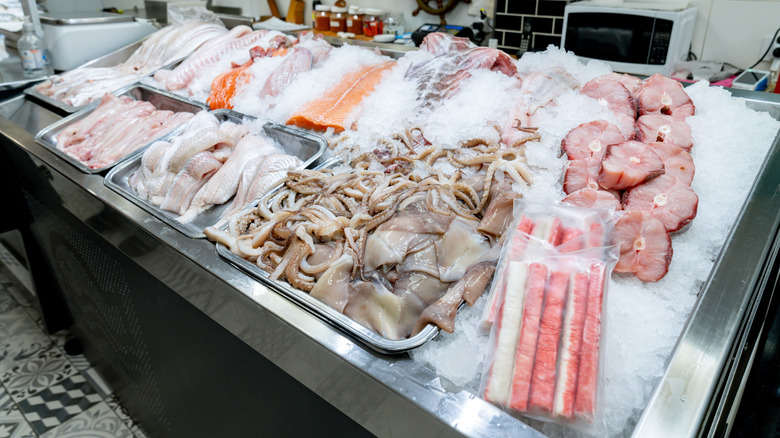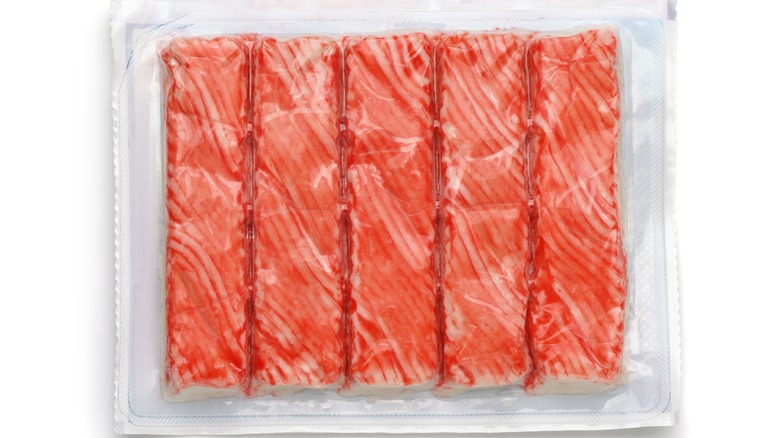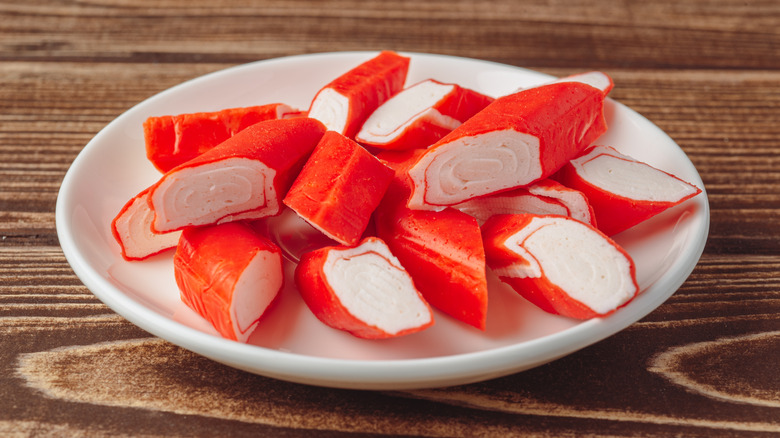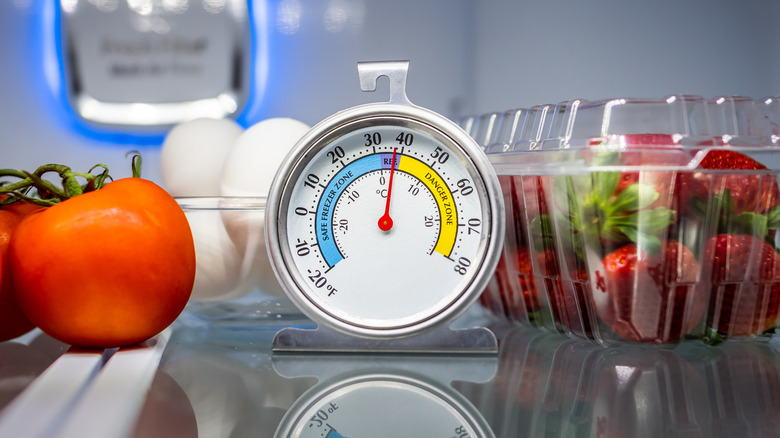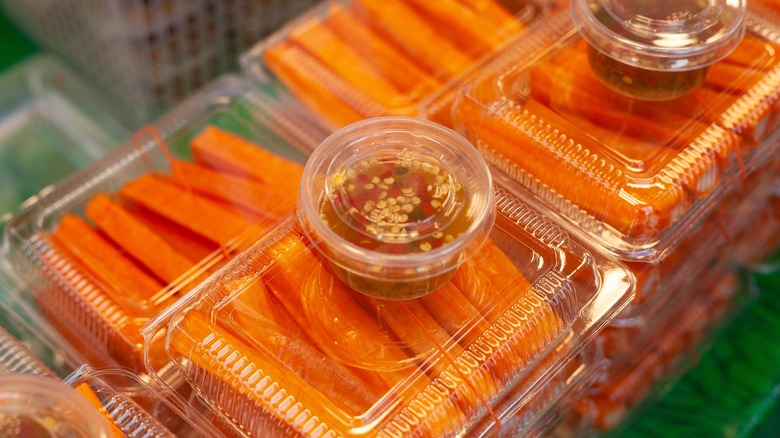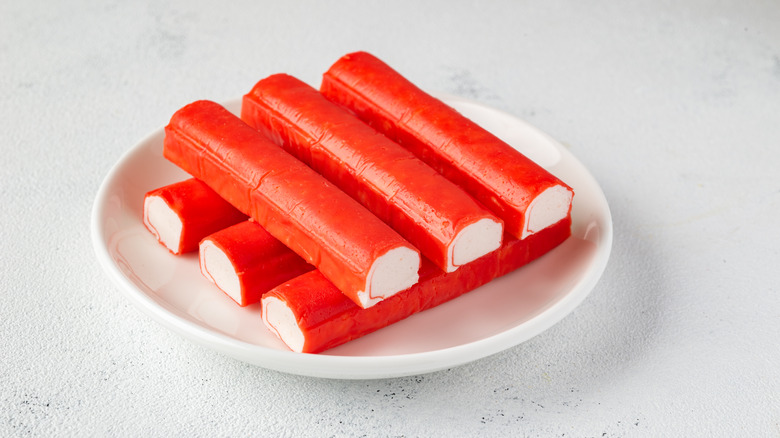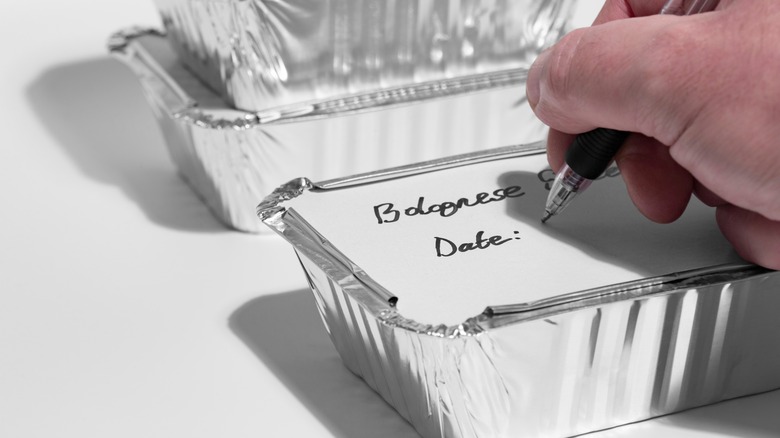You've Been Storing Imitation Crab All Wrong
If you are one of the many people who love crab but don't love its price tag, you may already be familiar with one of the best man-made wonders of the culinary world: imitation crab. What you may not be familiar with is how to properly store it.
Imitation crab is made of surimi, a blended paste composed of white fish (usually Alaskan Pollock), starch, sodium, sugar, and natural and artificial flavors. That paste is then put into slender molds and painted with a thin layer of orange food coloring to produce a stick of what looks like — and tastes like — a real crab leg. But since imitation crab is not really made from crab, are the storage rules the same? The answer to this is important, as improperly stored imitation crab meat can cause food-borne illness like listeriosis. If you want to store your imitation crab properly, read on to find out what you may have been doing wrong in the past so you can ensure a better future with your tasty (almost) crab.
Mistake: Thinking there's no need for refrigeration
Imitation crabmeat might not really be crab, but it is still fresh fish. For this reason, one should never assume that it can be stored at room temperature like canned tuna, which has been processed to make it more shelf-stable. In fact, imitation crab should never be left out of the refrigerator for more than two hours at a time. Ever. And once it is in the refrigerator, it should stay at a constant temperature to avoid spoilage.
When in doubt, you should follow the USDA's rules, which apply to all forms of fresh fish. These rules state that fresh fish and shellfish should be stored at a temperature below 40 degrees F. Fresh fish should also be either cooked or frozen within one or two days of purchase. If you cook it, leftovers can remain in the fridge for three to four days, while freezing extends the shelf life to several months.
Mistake: Not using a proper storage container
One of the biggest follies in food storage occurs when people think that their food storage container choice doesn't really matter. You can just chuck your loosely closed bag of imitation crab in the fridge next to the open onion and the cut lemon, right? Wrong!
Imitation crab should be placed in an airtight glass or plastic box or a resealable, food-safe bag. If you buy loose imitation crab meat from the fish section at the store, moving it to this second, more impenetrable, container should be the first thing on your agenda. Improperly stored imitation crab can take in air, moisture, and the flavors and smells of other things in your refrigerator or freezer.
More importantly, though, is the fact that an improperly sealed container can let in — and let out — bacteria. All uncooked fish is prone to carrying pathogens that may cause illness. These pathogens are usually killed when the fish is cooked, but if your imitation crab is not sealed correctly, those pathogens can jump ship onto things you would eat raw, like lettuce or tomatoes. This cross-contamination can lead to food poisoning, so it is best not to risk it.
Mistake: Freezing your meat in big chunks
Another mistake that many people make, not just with fish, but with every type of meat, is freezing it in one big, messy chunk. Not only does this make it difficult for the imitation crab to freeze evenly, but it also makes it nearly impossible to break off a smaller portion to cook for dinner without thawing the whole thing.
Instead of freezing all of your seafood in one big blob, portion it out. Separate the imitation crab into smaller portions, just enough for a meal, and freeze those portions in their own, individual box or bag. That way, when you need it, you can take out just as much as you need for a meal and the rest of it will remain fresh in the freezer. You should still, however, keep those smaller packages away from other things that may cause it to take on other smells or tastes, and you should be equally vigilant about their airtightness.
Mistake: Not storing imitation crab at the right temperature
If you want your imitation crab meat to last in the refrigerator or freezer, you need to be sure to store it at the right temperature. Since 38 degrees F is the sweet spot, it is recommended to keep the seafood on the bottom shelf where the refrigerator's temperature is usually lowest. To check that your fridge is at the proper temperature, you can purchase a specialized thermometer to keep inside the fridge if yours doesn't have one built-in. You can also use an instant-read meat thermometer to get a reading on the fly.
If you are storing your imitation crab meat in the freezer, the ideal temperature is at or below 0 degrees F. Not all home freezers are set to this temperature (most are around 10 degrees F), but if yours doesn't go that low, don't worry. You're still in the safe zone at 10 degrees F, but your imitation crab will stay good for around one year instead of two.
Mistake: Assuming shelf life is always the same
Shelf life is the amount of time that a food can be stored and remain edible. It varies based on how the food is stored, whether it is at a store, warehouse, or your house, and many other factors. Thusly, the shelf life of imitation crab meat varies. Pasteurized, vacuum-sealed imitation crab meat, for instance, has a shelf life of around two months in the refrigerator before it is opened. After it is open, that shelf life drops to three days. Loose imitation crab bought at the local market will remain good for three to five days if refrigerated properly. If you freeze your imitation crab, however, the shelf life extends to six months or more.
You should always keep an eye on the expiration dates on your packages and always check "best by" and "sell by" dates before buying anything. You should also keep in mind that it is not just the possibility of bacterial growth and illness that makes it unwise to keep imitation crab meat in the refrigerator for longer than recommended: The taste will also suffer. The texture and flavor of any fresh or frozen fish degrades with overly long storage, so it's best not to let it linger too long on the shelf.
Mistake: Thawing your imitation crab meat too soon
If you are planning to serve imitation crab one of the many delicious ways at a dinner party this weekend, don't be tempted to start thawing it out on Monday. Thawing out your imitation crab too early can lead to a host of problems, the biggest of which is that crab going bad before you can serve it.
To thaw out your imitation crab, place the frozen meat in the refrigerator around 24 hours before you need it. This allows it to defrost slowly and safely. Once it is thawed out, it should be used within three days.
If you change your mind about using it, though, don't put the imitation crab back in the freezer once it has been thawed. Freezing, thawing, then re-freezing fish is not usually recommended because it breaks down over time, reducing its quality; it will only degrade further with another thaw at a later time.
Mistake: Not being on the lookout for spoilage
Aside from being aware of the expiration date of imitation crab meat when you buy it, you should also be aware that this is not the only indicator of your fish's freshness. Before you eat any kind of fish, you should always do a visual check and, obviously, that infamous sniff test, before proceeding with your recipe. You can never be 100% sure whether the temperature of the meat changed during its storage of if something was off at the store where you bought it.
To know if your uncooked imitation crab has gone bad, start with a visual inspection. If you see browning, bruising, or a grayish color that doesn't match the bright, healthy orange-and-white glow it had when you bought it, your imitation crab is past its prime.
If the meat passes the visual check, it's time to give it a whiff. Does it smell like ammonia? Does it smell sour, extra fishy, or otherwise just rancid or gross? If so, toss it out.
Lastly, you can touch the imitation crab to see if it feels like it should. If you feel a slimy, mucus-like film on the exterior or the meat has a squishy texture, this means it's ready for that great imitation crab colony in the sky.
Mistake: Not writing the date on the package
This is one of the cardinal sins of food storage. If there were 10 commandments to keeping food fresh, one of them would undoubtedly be: "Thou shalt not forget to label thy food!"
There are two components to a good food label: the name and the date. Writing the name of the food helps you to distinguish between an opaque package of chicken strips and an opaque package of imitation crab in the freezer, but the date will let you know how long you have left to eat it.
When freezing your imitation crab meat, write the current date on each package with a permanent marker. This will let you know when it went into the freezer, which will let you know the order in which you should eat it (oldest first, by the way). While this labeling is usually associated with frozen foods, it can also be a good idea to label the imitation crab in your refrigerator with the date as well.

